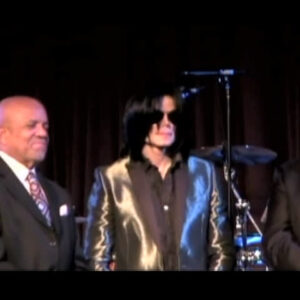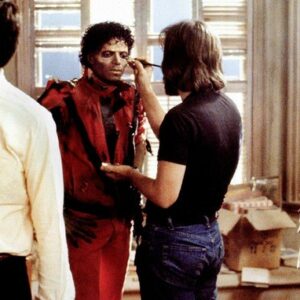The partnership between Michael Jackson and Quincy Jones represents one of the most iconic and influential collaborations in music history. Their union not only defined a generation but also permanently altered the course of pop music. Michael Jackson, often referred to as the “King of Pop,” was a rare musical prodigy whose talents were evident from a young age. On the other hand, Quincy Jones, a seasoned music producer, arranger, and conductor, had already cemented his place as a visionary in the music industry long before their paths crossed.
Michael Jackson’s career began as the lead singer of the Jackson 5, a family band that captured the hearts of audiences worldwide in the late 1960s and early 1970s. However, it was clear from early on that Jackson’s potential extended beyond his childhood success. As he matured as an artist, he sought to break free from the bubblegum pop image and explore more complex and personal themes in his music.
Quincy Jones was already a giant in the industry, having worked with some of the greatest jazz musicians of the 20th century, including Miles Davis, Count Basie, and Frank Sinatra. Known for his ability to blend different musical genres, Jones had a reputation for producing songs with depth, complexity, and, most importantly, soul. His experience in orchestration, arranging, and production made him one of the most versatile and respected figures in music.
The collaboration between these two titans began during the creation of Off the Wall in 1979, and what followed would revolutionize not just pop music, but the music industry as a whole.
How Their Partnership Started During Off the Wall Album
Michael Jackson and Quincy Jones first crossed paths while Jackson was filming The Wiz in 1978, a musical film adaptation of The Wizard of Oz in which Jackson played the Scarecrow. Quincy Jones was the musical supervisor for the film. During this time, Jackson expressed his desire to explore a more mature sound and artistic direction. Sensing the potential for something extraordinary, Jones agreed to collaborate with Jackson on what would become the singer’s breakthrough solo album, Off the Wall.
Jackson’s previous solo work had been more in line with his youthful persona from the Jackson 5, but Off the Wall marked a turning point. The album was a fusion of R&B, pop, jazz, and funk, and it allowed Jackson to showcase his versatility and range as an artist. Quincy Jones played a pivotal role in shaping this sound, utilizing his vast experience in blending genres to create a sophisticated, yet accessible, album.
Creative Synergy Between Michael Jackson and Quincy Jones
The partnership between Michael Jackson and Quincy Jones was marked by a rare creative synergy. Jackson had a boundless imagination and an unparalleled work ethic, while Jones brought decades of musical knowledge and production experience to the table. Together, they formed a dynamic duo where Jackson’s vision was elevated by Jones’ expertise.
Jones’ ability to nurture Jackson’s creative impulses while guiding him with a disciplined hand resulted in a string of groundbreaking albums. One of Jones’ greatest strengths was his ability to balance Jackson’s instinctive musicality with his own structured approach to production. Jackson was known for his perfectionism, often obsessing over the smallest details of his music, while Jones could offer a broader perspective, helping Jackson refine his ideas into polished, radio-friendly hits.
Jones’ expertise in production, orchestration, and arrangement was key to elevating Jackson’s music to new heights. He knew how to arrange a song to maximize its emotional impact, whether it was through intricate string arrangements, layered vocal harmonies, or a driving rhythm section. His production style was sophisticated yet accessible, allowing Jackson’s music to appeal to a wide audience without losing its artistic integrity.
Impact of Off the Wall and Thriller
When Off the Wall was released in 1979, it was a critical and commercial success, marking Michael Jackson’s emergence as a solo superstar. The album’s fusion of R&B, pop, and disco helped define the sound of late-70s pop music, and it spawned several hit singles, including “Don’t Stop ’Til You Get Enough” and “Rock with You.” Off the Wall was more than just a successful album; it was a cultural milestone that reflected the changing landscape of music at the end of the 1970s.
However, Off the Wall was only the beginning. In 1982, Jackson and Jones reunited for Thriller, an album that would go on to become the best-selling album of all time. Thriller was a cultural phenomenon that transcended music. Its groundbreaking music videos, particularly for songs like “Billie Jean” and “Thriller,” helped establish the music video as a legitimate art form and a key promotional tool for artists.
The transition from Off the Wall to Thriller was marked by an even greater ambition on Jackson’s part. He wanted Thriller to appeal to everyone, regardless of age, race, or nationality. Quincy Jones helped him achieve this by incorporating elements of rock, funk, and even classical music into the album. Songs like “Beat It” and “Thriller” showcased this genre-blending approach, with rock guitarist Eddie Van Halen providing a memorable solo on “Beat It,” and the iconic Vincent Price voiceover on “Thriller” adding a cinematic quality to the track.
The success of Thriller cemented Michael Jackson’s status as the “King of Pop” and solidified Quincy Jones’ reputation as one of the greatest producers in music history. Together, they had created a body of work that not only defined an era but also set a new standard for pop music.
Behind the Scenes: Iconic Tracks and Their Creation
Some of the most iconic tracks from Off the Wall and Thriller were the result of a meticulous and collaborative process between Jackson, Jones, and a host of talented musicians and songwriters. Songs like “Don’t Stop ’Til You Get Enough,” “Billie Jean,” and “Beat It” were crafted through a combination of Jackson’s vision, Jones’ production expertise, and the contributions of a diverse group of session musicians and songwriters.
“Don’t Stop ’Til You Get Enough,” one of the standout tracks from Off the Wall, was written by Jackson himself and featured his signature falsetto and infectious energy. Quincy Jones helped refine the song’s arrangement, creating a danceable groove that would become one of Jackson’s trademarks.
“Billie Jean,” from Thriller, was another example of the Jackson-Jones magic. Jackson was insistent on the song’s bass line, which he had imagined perfectly in his head. Jones, who initially had reservations about the song, worked with Jackson to fine-tune the production, adding subtle details like the distinctive snare drum sound and a haunting string arrangement that gave the track its moody atmosphere.
“Beat It” was a fusion of rock and pop that helped break down racial barriers in music. Jackson wanted to create a song that would appeal to rock fans, and Quincy Jones brought in Eddie Van Halen to provide a searing guitar solo. The result was a track that became an anthem for both pop and rock audiences, further solidifying Jackson’s crossover appeal.
Long-lasting Influence on the Music Industry
The influence of Michael Jackson and Quincy Jones’ collaboration extends far beyond the albums they created together. Their work has had a lasting impact on the music industry, inspiring countless artists, producers, and songwriters. The genre-blending approach that Jones and Jackson pioneered has become a staple in modern pop music, with artists like Beyoncé, Bruno Mars, and The Weeknd drawing on their legacy.
Off the Wall and Thriller also revolutionized the way music was marketed and consumed. The success of Jackson’s music videos helped establish MTV as a cultural force and made music videos an essential part of an artist’s promotional strategy. The production techniques that Jones employed on these albums, such as the use of sophisticated orchestration and multi-layered arrangements, have become standard practice in the industry.
Quincy Jones’ Production Philosophy and Influence
Quincy Jones’ production philosophy was rooted in his deep understanding of music theory and his ability to fuse different genres into a cohesive whole. He drew on a wide range of influences, from jazz and classical music to R&B and funk, and he was always willing to experiment with new sounds and technologies.
Jones’ ability to create music that appealed to a global audience was one of his greatest strengths. He understood that great music transcends cultural and linguistic barriers, and he was able to craft songs that resonated with listeners around the world. His work with Michael Jackson exemplified this approach, as the albums they created together had a universal appeal that crossed geographical and demographic boundaries.
The Legacy of Their Collaboration
Even after Thriller, Michael Jackson and Quincy Jones continued to influence the music industry in profound ways. Jackson’s career evolved with albums like Bad and Dangerous, while Jones went on to produce and mentor a new generation of artists. The impact of their collaboration is still felt today, with their work serving as a benchmark for excellence in music production.
Quincy Jones’ legacy as a producer, arranger, and composer is unmatched, and his influence can be seen in the work of contemporary artists across all genres. Michael Jackson’s music continues to inspire and entertain fans around the world, and his work with Jones remains a defining chapter in his storied career.
The collaboration between Michael Jackson and Quincy Jones not only shaped the sound of pop music in the 1980s but also set the stage for the future of music production. Their partnership was a testament to the power of collaboration and the magic that can happen when two visionary artists come together.





